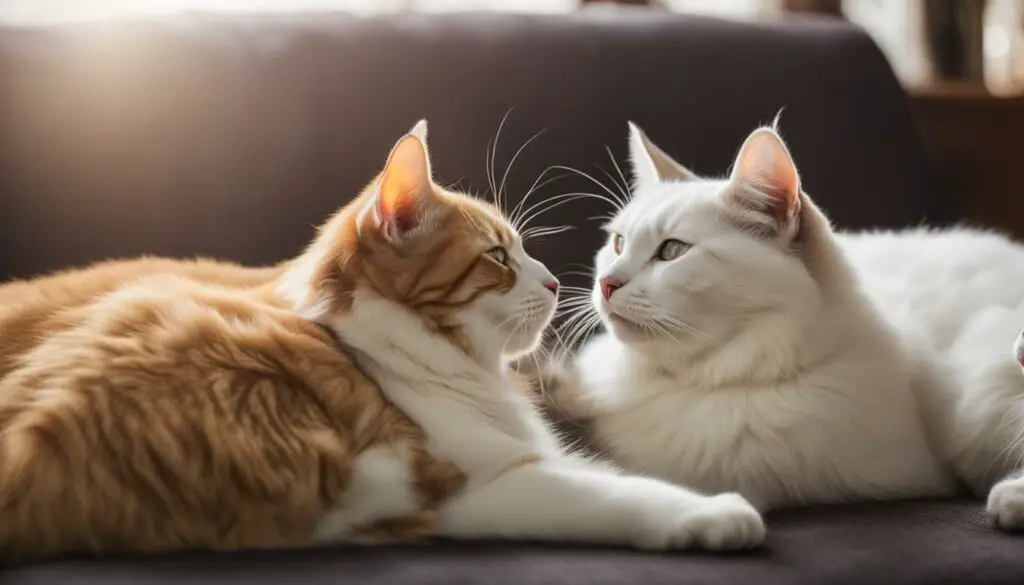Have you ever wondered why cats are so meticulous about grooming? As a cat lover myself, I’ve always been intrigued by the fascinating behavior of cats bathing each other. It’s a common sight to see feline friends lovingly licking and cleaning each other. But what drives this grooming behavior? Let’s dive into the world of cat grooming to uncover the reasons behind this intriguing habit.
Key Takeaways:
- Cat grooming behavior serves multiple purposes, including communication, bonding, dominance, and hygiene.
- Grooming is a way for cats to show trust and respect to other cats in their group or family.
- Cats groom each other to strengthen their bond and establish a sense of trust and affection.
- Grooming can be a way for cats to assert dominance within a group or hierarchy.
- Mother cats have a strong instinct to groom their kittens, even after they have grown.
Communicating Relationships
Cats groom each other as a way to communicate their relationships. It is a behavior that goes beyond basic hygiene and serves as a means of showing trust and respect to other cats in their group. This grooming ritual indicates that certain cats are closer and more bonded than others in the same colony or family.
In a home setting, cats may also groom their human owners as a way to express their bond. This behavior demonstrates that cats see their human family members as part of their group and accept them as part of their territory.
Overall, grooming is a powerful form of communication among cats. By engaging in reciprocal grooming, cats strengthen their social bonds, foster trust, and establish their hierarchy within a group or family.
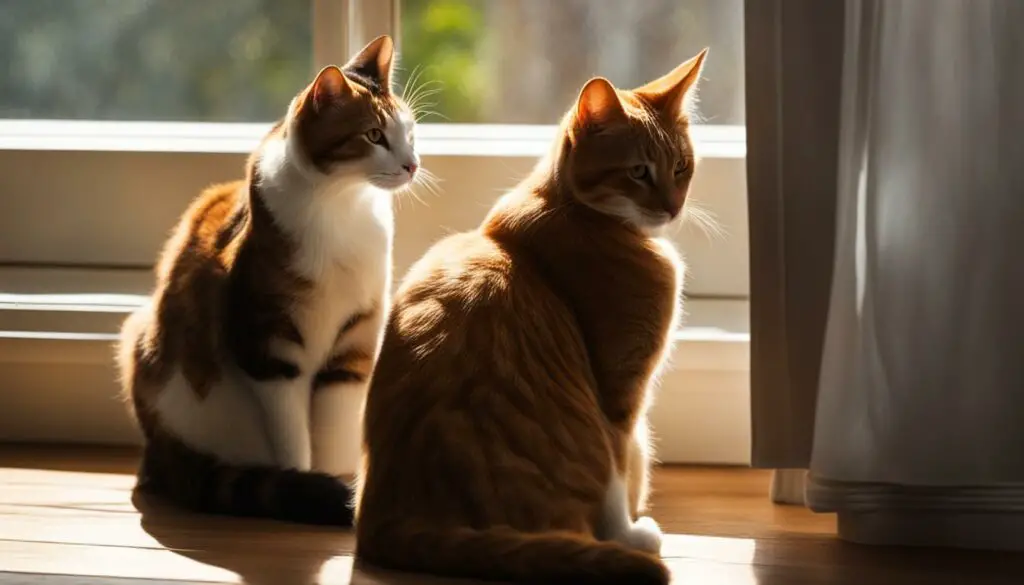
A Closer Look: Communicating Relationships
The reciprocal grooming behavior among cats is a fascinating aspect of their social dynamics. It reflects their innate need for companionship and their ability to establish complex relationships. Through grooming, cats communicate their place within a social group and express their acceptance of other cats. It is a subtle yet powerful indication of the bonds that cats form with one another.
| Cats grooming each other to show trust and respect | Cat grooming behavior as a form of communication |
|---|---|
| Grooming indicates that certain cats are closer and more bonded than others in the group. | Cats groom each other to communicate their place within the social hierarchy. |
| Grooming rituals strengthen social bonds, foster trust, and establish hierarchy. | Reciprocal grooming behavior reflects the acceptance of other cats in their territory. |
Grooming is a language that cats speak to each other, a way for them to express trust and respect. It goes beyond simple cleaning and serves as a means of communication within their social groups. By grooming one another, cats establish and reinforce their relationships, creating a strong sense of bonding and acceptance.
Bonding
Grooming is an important aspect of bonding between cats. Littermates and cats who have lived together for a long time often groom each other as a way to show their bond and strengthen their friendship. This mutual grooming behavior helps cats establish a sense of trust and affection towards one another.
When cats engage in grooming sessions, they are not only cleaning each other’s fur but also engaging in a social activity that strengthens their relationship. It is a way for cats to communicate and express their affection. Through grooming, cats exchange scents, which helps them recognize each other as part of their social group.
For littermates, grooming plays a crucial role in their development and socialization. It starts from an early age when they are still kittens and continues into adulthood. The act of grooming helps them form a deep bond that lasts a lifetime. In addition to littermates, cats who have lived together for a significant amount of time also engage in grooming as a way to reinforce their friendship and maintain their social connection.
| Grooming as Bonding | Grooming as Social Activity |
|---|---|
| Grooming strengthens the bond between cats, especially littermates. | Grooming is a way for cats to communicate and express affection to one another. |
| Grooming starts from an early age and continues into adulthood. | Through grooming, cats exchange scents and recognize each other as part of their social group. |
| Grooming helps cats form a deep and lasting bond. | Cats who have lived together for a long time groom each other to reinforce their friendship. |
Grooming is not only a physical activity for cats but also a way for them to strengthen their emotional connection. It is a behavior that goes beyond keeping their fur clean and well-groomed. By engaging in grooming sessions, cats fulfill their social and bonding needs, helping them maintain a harmonious and supportive relationship with their feline companions.
Dominance in Cat Grooming: Establishing Hierarchy and Understanding Social Dynamics
When cats groom each other, it’s not just about cleanliness and hygiene. This behavior also serves as a way for cats to establish dominance within their group or family. In the wild, grooming is often used as a means of showing hierarchy in big cat prides. Similarly, domestic cats may engage in grooming to assert their higher social status over other cats.
However, it’s important to note that not all groups of cats exhibit dominance-induced grooming. In some cases, cats may groom each other simply as a form of social bonding or to maintain their relationships. The dynamics of cat groups can vary, and while grooming can be a way of establishing dominance, it’s not the sole purpose.
Understanding the role of dominance in cat grooming helps us gain insights into feline social dynamics. By observing this behavior, we can better comprehend the complex relationships between cats and how they communicate with each other. It’s fascinating to witness how cats navigate their social hierarchy through grooming and other behaviors.
Factors Affecting Dominance-Induced Grooming
Several factors can influence the frequency and intensity of dominance-induced grooming in cats. These include the individual personalities and temperaments of the cats involved, the size of the group, and the resources available to them. If resources become limited, such as food or territory, grooming behaviors may increase as a way to assert dominance and secure access to those resources.
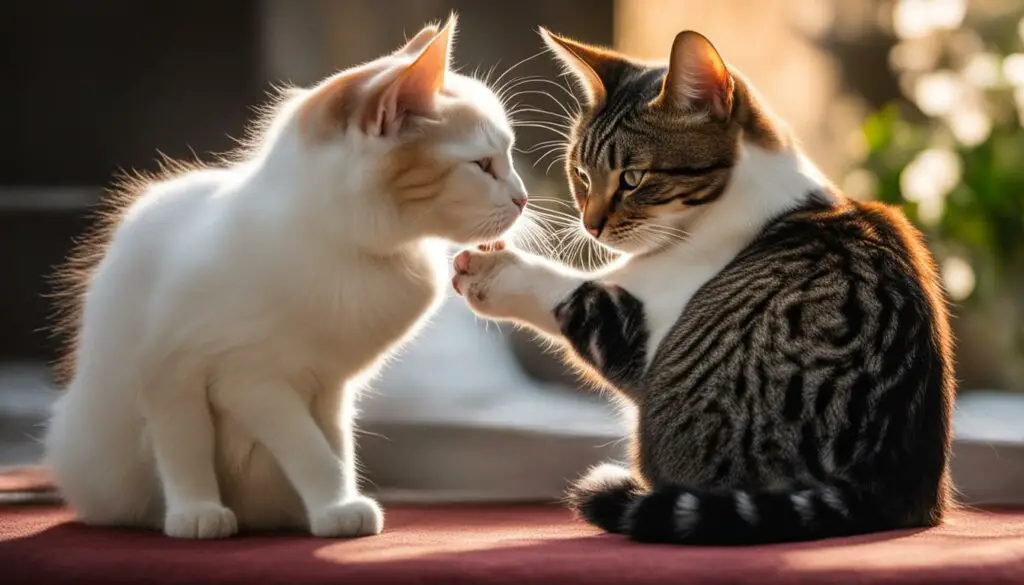
Overall, the interplay between dominance and grooming in cats adds a fascinating layer to their social dynamics. It showcases the complex nature of feline relationships and provides a window into how cats communicate and establish their place within a group or family.
Next, we’ll explore the special bond between mother cats and their kittens, shedding light on the importance of grooming in maternal relationships.
Mothers and Kittens
One of the most touching aspects of feline behavior is the grooming relationship between mother cats and their kittens. It is a natural instinct for mother cats to groom their newborn kittens. This grooming serves multiple purposes and helps create a strong bond between the mother and her offspring. The grooming instinct is ingrained in mother cats and is an essential part of their role as caregivers.
The grooming process starts right after birth, as the mother cat cleans the amniotic fluid and other debris from her kittens. This initial grooming serves to stimulate the kittens’ circulation, breathing, and digestion. It also helps establish the mother’s scent on her offspring, which is crucial in recognizing and bonding with them. As the kittens grow, the mother continues to groom them regularly, ensuring their cleanliness and health.
But the grooming is not a one-way street. Kittens also play an active role in this relationship. They instinctively seek out their mother’s grooming sessions, positioning themselves to be easily reached by her tongue. This mutual grooming reinforces the bond between mother and kittens and helps the kittens learn proper grooming techniques. It is an essential part of their early socialization and the development of their overall grooming skills.
The Importance of Maternal Bonding through Grooming
The maternal grooming behavior plays a vital role in the overall well-being of the kittens. Through grooming, the mother cat not only keeps her offspring clean but also helps them regulate their body temperature. Additionally, the grooming process stimulates blood flow, aids in digestion, and helps prevent matting of the fur. It also provides comfort and a sense of security for the kittens, as they feel nurtured and loved by their mother.
In conclusion, the grooming relationship between mother cats and their kittens is a beautiful display of maternal care and bonding. It is a natural instinct that serves important functions in ensuring the health and development of the kittens. Observing this behavior can help us appreciate the intricate nature of feline social dynamics and the special bond between a mother cat and her kittens.
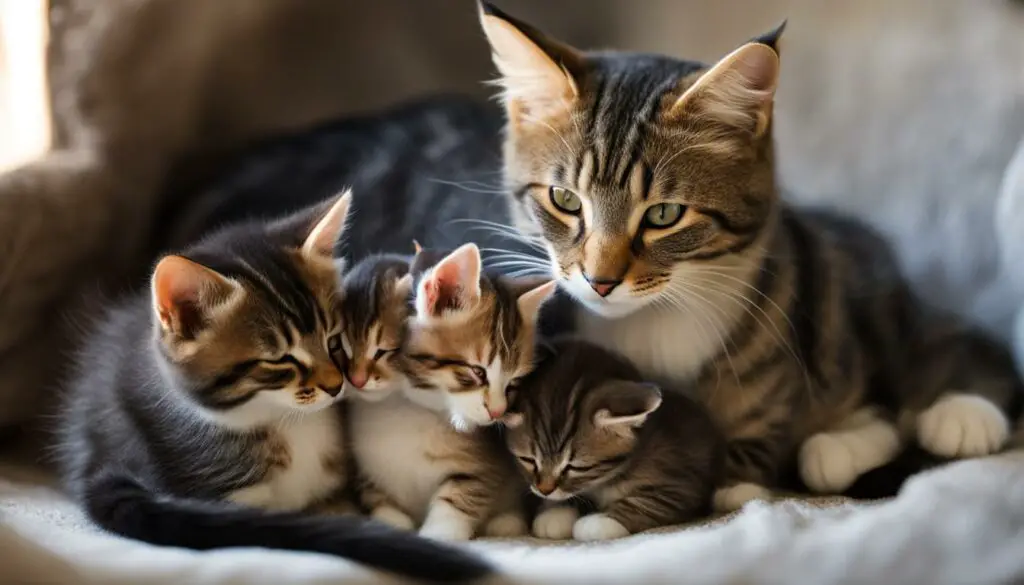
Cats Grooming to Show Acceptance
When cats groom each other, it is a significant display of acceptance within their social groups. By engaging in grooming behaviors, cats communicate that they see the other cat as part of their territory, colony, or family. This territorial grooming behavior is also commonly observed when cats groom their human family members, extending their social bonds beyond their own species. It is fascinating to witness how these small acts of grooming can convey a sense of trust and acceptance in the feline world.
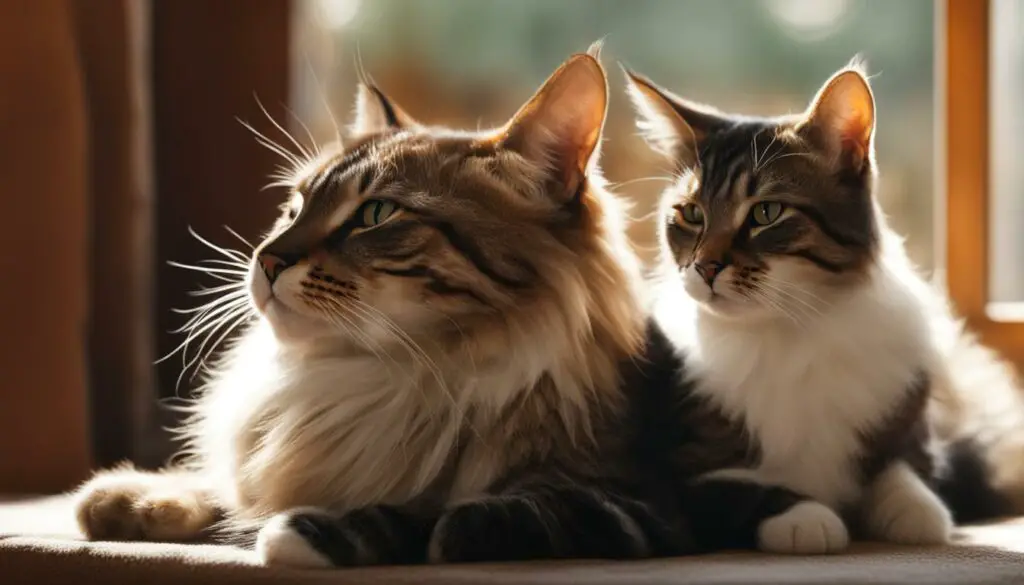
Within cat families, grooming plays a vital role in establishing and maintaining harmonious relationships. When cats groom each other, they are strengthening the bond between them. This mutual grooming behavior fosters a sense of trust and affection, reinforcing their social connections. It is particularly prevalent among littermates and cats that have lived together for an extended period. Through grooming, cats create an environment of acceptance and unity within their family structure.
| Cat Family Dynamics | Characteristics |
|---|---|
| Social Structure | Establishes and maintains hierarchy |
| Bonding Mechanism | Strengthening social relationships |
| Accepted Members | Cats within the same territory or household |
| Significance | Fosters trust, unity, and a sense of belonging |
Grooming behaviors in cats are essential in maintaining both physical hygiene and social connections. By grooming each other, cats ensure that hard-to-reach areas, such as beneath the chin, stay clean and well-maintained. This assistance in cleanliness strengthens their social bonds and contributes to the overall well-being of the group. It is a fascinating aspect of feline behavior that showcases the intricate dynamics and communication mechanisms within cat families.
Grooming Assistance: Cats Helping Each Other Stay Clean
When it comes to grooming, cats are known for their fastidious nature. They meticulously clean themselves, ensuring that every part of their body is well-groomed. However, there are certain areas that cats find hard to reach on their own, such as the back of their neck and under their chin. This is where the assistance of another cat comes in handy.
“Cats are self-groomers, but they also engage in mutual grooming behavior to help each other reach those difficult areas,” says Dr. Emily Collins, a feline behavior expert. “It’s a sign of cooperation and social bonding within a feline group.”
Mutual grooming, also known as allogrooming, serves not only as a way to maintain hygiene but also as a bonding activity between cats. By grooming each other, cats engage in a reciprocal behavior that strengthens their social bonds and fosters a sense of trust and acceptance.
To illustrate the importance of grooming assistance among cats, it can be beneficial to observe a group of cats living together. In a typical grooming session, one cat may groom another, focusing on hard-to-reach areas. This behavior not only keeps the cats clean but also helps them maintain a healthy coat and prevent any potential skin issues.
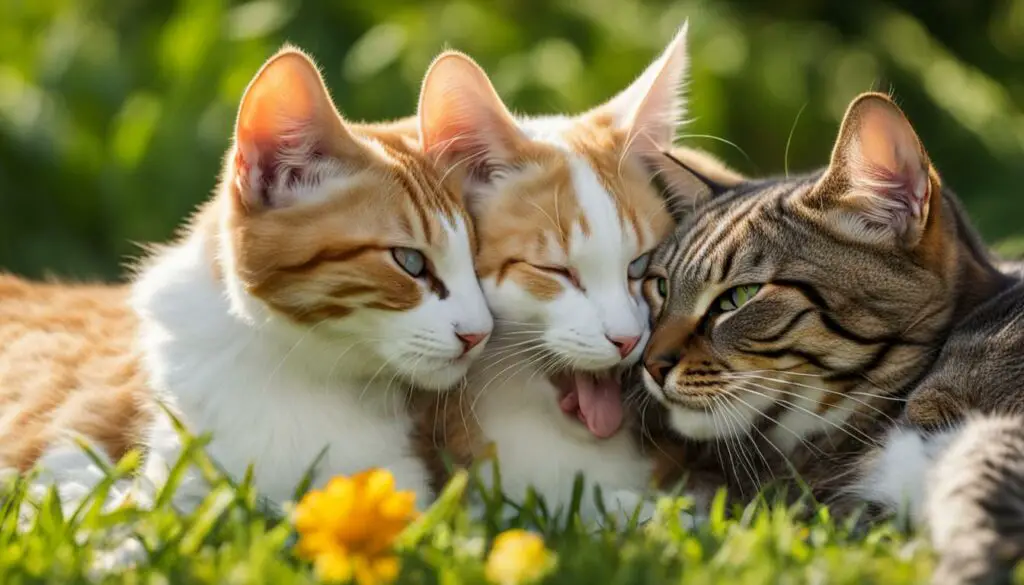
While grooming assistance primarily benefits the recipient cat by aiding in hygiene maintenance, it also carries a psychological benefit for both cats involved. The act of grooming releases endorphins, which have a calming effect and can reduce stress levels in cats. This shared activity contributes to the overall well-being of the feline group, promoting a harmonious and peaceful environment.
In conclusion, cats grooming each other to provide cleaning assistance is a natural and important behavior in feline social dynamics. It allows cats to reach and clean areas that are challenging to groom on their own, while also strengthening the bonds between them. Mutual grooming not only promotes hygiene but also contributes to the mental well-being of cats.
It’s Very Normal for Cats to Groom Each Other
Cats grooming each other is a perfectly normal and natural behavior. It indicates that cats are bonded and close with each other. While it may not signify the same kind of love humans understand, it does show a strong bond in cat terms. It is important to ensure that both cats are healthy and free of parasites when they engage in mutual grooming.
Grooming is a significant part of feline social behavior. Cats groom each other as a way to communicate their relationships, establish dominance, bond with each other, provide cleaning assistance, and show acceptance. This behavior is rooted in their social nature and instincts. By grooming each other, cats strengthen social bonds, maintain cleanliness, regulate body temperature, and relieve stress.
Moreover, grooming also serves as a form of acceptance. When a cat grooms another cat, it is a sign that they no longer see the other cat as a threat but as a member of their group. This behavior can also extend to human family members, as cats may groom their owners to express their bond and acceptance. It is a way for cats to establish trust, show respect, and solidify their relationships.
Introduction to Feline Behaviour
Understanding cat behavior is key to unraveling the mysteries of why cats groom each other. Contrary to popular belief, cats are social creatures at heart, thanks to their wild ancestors who lived in groups. This social aspect of their nature is still present in domestic cats today. By delving into the intricacies of feline social behavior, we can gain valuable insights into the reasons behind cats’ grooming habits.
Feline social behavior encompasses various aspects, including communication, bonding, hierarchy, and acceptance within a group or family unit. Cats have their own unique ways of expressing these behaviors, and grooming is one of the most notable and fascinating examples.
As social creatures, cats use grooming not only to clean themselves but also to communicate with other cats. Through grooming, they build trust, strengthen relationships, and establish their place within the social hierarchy. It’s an intricate dance of cleanliness and connection that plays a vital role in a cat’s well-being.
The Social Nature of Cats
One of the fundamental aspects of feline behavior is their social nature. Cats form complex social structures, whether living in a multi-cat household or in colonies. They navigate social dynamics, develop bonds, and communicate through a combination of vocalizations, body language, and, yes, grooming. Understanding the innate sociability of cats is crucial in unraveling the reasons behind their grooming behavior.
| Key Aspects of Feline Social Behavior | Examples |
|---|---|
| Communication | Cats groom each other as a way to communicate their relationships and social status within a group or family. |
| Bonding | Grooming is a vital aspect of bonding between cats, helping them establish trust, affection, and a sense of belonging. |
| Hierarchy | Grooming can be used by cats to assert dominance or establish social order within a group. |
| Acceptance | Cats groom each other to indicate acceptance, whether it’s accepting a new member into their territory or showing affection towards their human companions. |
The intricate social behavior of cats, coupled with their grooming habits, showcases the depth of their connections and the fascinating world they inhabit. By observing and understanding these behaviors, we can gain a deeper appreciation for the complex nature of our feline friends.

The Mystery of Mutual Grooming
Mutual grooming, also known as allogrooming, is a fascinating behavior in cats that goes beyond mere cleaning. It carries deeper meanings and subtle implications that contribute to the complex social dynamics of feline groups. While grooming each other, cats engage in a multitude of interactions that serve various purposes, from strengthening bonds to regulating body temperature.
Allogrooming is an essential part of feline social behavior, allowing cats to bond and establish trust with one another. Through grooming, cats communicate their acceptance and closeness to members of their group or family. It acts as a form of social glue that strengthens relationships and maintains harmony within the cat community.
Grooming also plays a role in hygiene maintenance, particularly in hard-to-reach areas. Cats rely on each other to groom spots that are challenging to clean on their own, ensuring that they stay clean and free from dirt and parasites. Additionally, mutual grooming has been observed to have a calming effect, reducing stress levels and promoting mental well-being in cats.
| Benefits of Mutual Grooming in Cats |
|---|
| Strengthening social bonds |
| Maintaining hygiene |
| Regulating body temperature |
| Reducing stress levels |
“Mutual grooming is not just about cleaning each other; it’s a way for cats to communicate trust, build relationships, and establish social hierarchy.”
Understanding the deeper meaning behind mutual grooming helps us appreciate the intricate nature of cats’ social lives. It reminds us that cats are not solitary creatures, but rather highly social animals with complex communication systems. By observing and appreciating this behavior, we can better ensure the health and happiness of our feline companions.
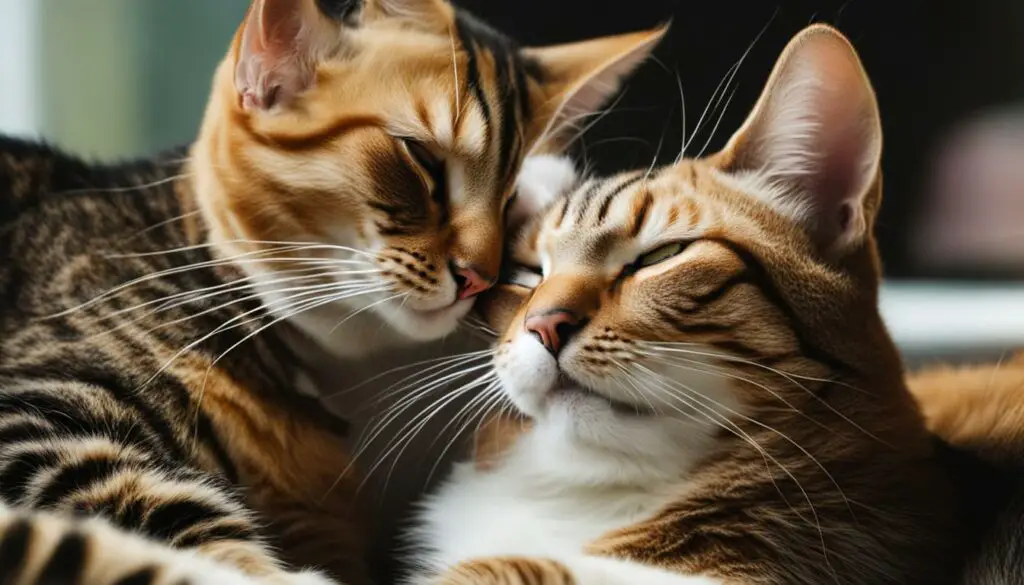
Biological Reasons for Cats Grooming Each Other
Cats groom each other for various biological reasons, which contribute to their social bonding, hygiene maintenance, and body heat regulation. Mutual grooming plays a vital role in strengthening social bonds among cats. When cats groom each other, they engage in a reciprocal behavior that fosters a sense of trust and companionship.
In terms of hygiene, grooming helps cats maintain cleanliness, especially in hard-to-reach areas. Cats rely on each other to access difficult spots like their chin or back, ensuring that their entire body remains clean and free from dirt or parasites. Additionally, grooming stimulates the secretion of natural oils in a cat’s coat, keeping it healthy and shiny.
Grooming also aids in body heat regulation for cats. During grooming, cats’ bodies produce friction, which generates warmth. This self-grooming technique helps cats cool down in hot weather or stay warm in colder temperatures. It’s an instinctive behavior that allows cats to regulate their body temperature for overall comfort.
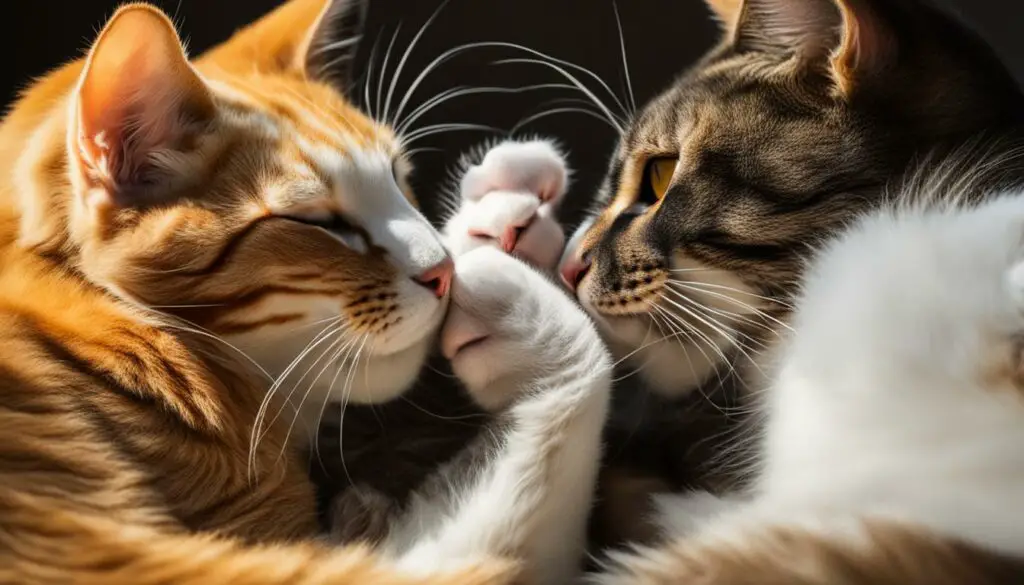
Table: Social Bonding, Hygiene Maintenance, and Body Heat Regulation in Cats
| Benefits | Description |
|---|---|
| Social Bonding | Grooming strengthens social bonds and fosters trust among cats. |
| Hygiene Maintenance | Grooming ensures cats stay clean, removing dirt and parasites from their fur and accessing hard-to-reach areas. |
| Body Heat Regulation | Grooming generates friction, helping cats cool down or stay warm depending on the temperature. |
Grooming is a natural and essential behavior for cats, serving both biological and social purposes. By understanding the reasons behind this behavior, cat owners can appreciate the importance of grooming in their feline companions’ lives and ensure their well-being.
Psychological Reasons
Allogrooming, or cats grooming each other, serves not only physical purposes but also has significant psychological benefits for cats. This behavior offers stress relief and has a calming effect on the individuals involved. Grooming acts as a soothing activity, helping cats cope with anxiety and promoting their overall mental well-being.
Cats are known for their independent nature, but they also have emotional needs that require attention. Engaging in grooming sessions allows them to fulfill their instinctual desire for social interaction and connection. The act of grooming stimulates the release of endorphins, which are feel-good hormones that contribute to a sense of relaxation and contentment in cats. It serves as a form of self-care, helping cats regulate their emotions and reduce stress levels.
Grooming is not only about cleanliness; it is a powerful tool for cats to maintain their mental health and establish a sense of inner peace.
By devoting time and energy to mutual grooming, cats create a tranquil atmosphere within their social groups, promoting harmony and reducing tension. Regular grooming sessions not only strengthen the bonds between cats but also provide a sense of security and reassurance. The act of grooming helps cats establish trust and build positive associations, leading to a more cohesive and stable social dynamic.
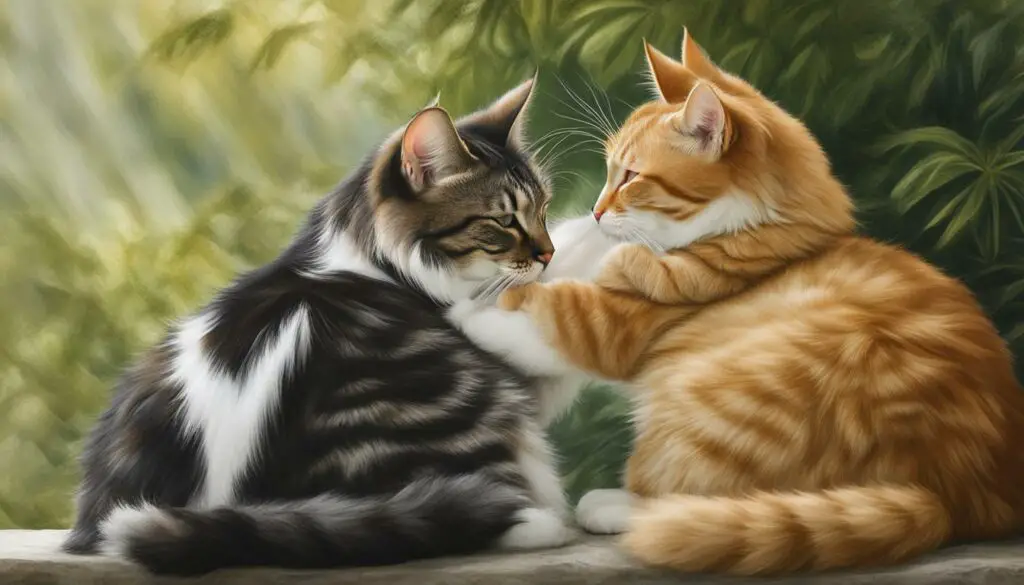
The Calming Effect of Grooming
The calming effect of grooming extends beyond the immediate moment of physical contact. It has a lasting impact on a cat’s emotional well-being. Through grooming, cats experience a deep sense of relaxation, which can help them navigate through stressful situations and reduce anxiety levels. Regular grooming sessions provide cats with a reliable coping mechanism and contribute to their overall mental resilience.
In conclusion, grooming is not only about cleanliness; it is a powerful tool for cats to maintain their mental health and establish a sense of inner peace. The stress relief and calming effects of grooming help cats cope with anxiety, reduce tension, and promote overall well-being. Understanding the psychological benefits of grooming allows us to create an environment that supports our feline companions’ emotional needs and helps them lead happy, healthy lives.
Conclusion
In conclusion, understanding feline social dynamics is key to comprehending the complex behavior of cats grooming each other. This behavior serves multiple purposes, including communication, bonding, dominance establishment, and hygiene maintenance.
Cats groom each other to communicate their relationships and show trust, respect, and acceptance within a group or family. It is a way for cats to strengthen their social bonds and express their close connection to other cats and even their human owners.
The act of grooming also plays a role in establishing dominance, especially in big cat groups. However, not all cats engage in this dominance-induced grooming behavior. Mother cats have a strong instinct to groom their kittens, helping them with their first bathroom experience and continuing to groom even after their kittens have grown.
Allogrooming, or mutual grooming, is perfectly normal and natural for cats. It goes beyond surface-level cleaning and has additional benefits, such as regulating body temperature and promoting mental well-being by reducing stress levels. By observing and understanding this behavior, we can ensure the health and happiness of our feline companions.
FAQ
Why do cats groom each other?
Cats groom each other to communicate their relationships, bond with each other, establish dominance, provide cleaning assistance, and show acceptance.
What does grooming each other signify in cats?
Grooming is a way for cats to show trust and respect to other cats, indicating a closer relationship than with other members of the same group or family.
Do cats groom each other to bond?
Yes, mutual grooming helps cats establish a sense of trust and affection towards one another and strengthens their friendship.
Is grooming a way for cats to establish dominance?
In some cases, cats may groom each other to establish hierarchy, especially in situations where one cat grooms another to assert higher social status.
Why do mother cats groom their kittens?
Mother cats have a strong instinct to groom their kittens to help with their first bathroom experience and establish maternal bonding.
What does it mean when cats groom each other to show acceptance?
By grooming another cat, cats are signifying that they see the other cat as part of their group or family, indicating acceptance and belonging.
Why do cats groom each other in hard-to-reach areas?
Cats may groom each other to provide cleaning assistance in areas that are difficult for them to reach on their own, ensuring hygiene and cleanliness.
Is it normal for cats to groom each other?
Yes, cats grooming each other is a perfectly normal behavior that shows they are bonded and close with one another.
Are cats social creatures?
Contrary to popular belief, cats are social creatures due to their wild ancestors living in groups, and this social aspect is still present in domestic cats.
What is the significance of mutual grooming in cats?
Mutual grooming, also known as allogrooming, is a key aspect of feline social behavior that helps cats bond, maintain hygiene, regulate body temperature, and reduce stress levels.
Why do cats groom each other biologically?
Cats groom each other to aid in social bonding, hygiene maintenance, reaching hard-to-get spots, and regulating body heat and temperature.
Does grooming have psychological benefits for cats?
Yes, grooming offers stress relief, has a calming effect, and helps cats cope with anxiety, promoting overall mental well-being.
How can I ensure my cats’ grooming behavior is healthy?
It is important to observe the grooming behavior of your cats and ensure they are healthy and free of parasites. If you have any concerns, consult with a veterinarian for professional advice.

